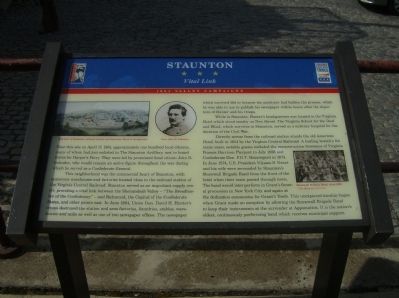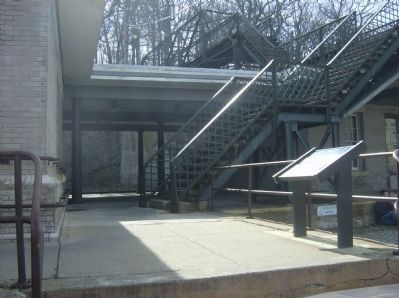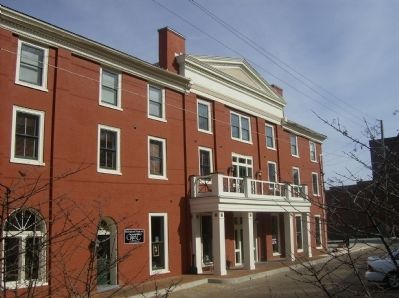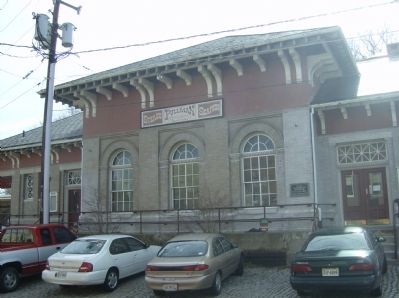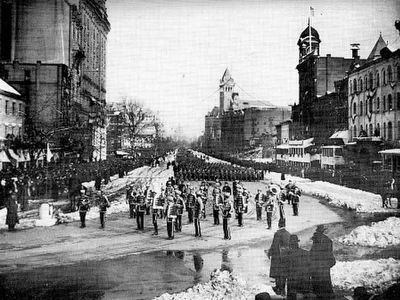Staunton, Virginia — The American South (Mid-Atlantic)
Staunton
Vital Link
— 1864 Valley Campaigns —
This neighborhood was the commercial heart of Staunton, with numerous warehouses and factories located close to the railroad station of the Virginia Central Railroad. Staunton served as an important supply center, providing a vital link between the Shenandoah Valley – “The Breadbasket of the Confederacy” – and Richmond, the Capital of the Confederate States, and other points east. In June 1864, Union Gen. David H. Hunter’s troops destroyed the station and area factories, foundries, stables, warehouses and mills as well as one of two newspaper offices. The newspaper which survived did so because the publisher had hidden the presses, which he was able to use to publish his newspaper within hours after the departure of Hunter and his troops.
While in Staunton, Hunter’s headquarters was located in the Virginia Hotel which stood nearby on New Street. The Virginia School for the Deaf and Blind, which survives in Staunton, served as a military hospital for the duration of the Civil War.
Directly across from the railroad station stands the old American Hotel, built in 1854 by the Virginia Central Railroad. A leading hostelry for many years, notable guests included the reconstruction Governor of Virginia Francis Harrison Pierpont in July 1866 and Confederate Gen. P.G.T. Beauregard in 1874. In June 1874, U.S. President Ulysses S. Grant and his wife were serenaded by Staunton’s Stonewall Brigade Band from the front of the hotel when their train passed through town. The band would later perform in Grant’s funeral procession in New York City and again at the dedication ceremonies for Grant’s Tomb. This unexpected kinship began when Grant made an exception by allowing the Stonewall Brigade Band to keep their instruments at the surrender at Appomattox. It is the nation’s oldest, continuously performing band which receives municipal support.
Erected by Shenandoah Valley Battlefields Foundation & Virginia Civil War Trails.
Topics and series. This historical marker is listed in these topic lists: Railroads & Streetcars • War, US Civil. In addition, it is included in the Virginia Civil War Trails series list. A significant historical month for this entry is April 1863.
Location. 38° 8.843′ N, 79° 4.367′ W. Marker is in Staunton, Virginia. Marker is on Middlebrook Avenue (State Highway 252), on the left when traveling west. Touch for map. Marker is in this post office area: Staunton VA 24401, United States of America. Touch for directions.
Other nearby markers. At least 8 other markers are within walking distance of this marker. History of the C&O Station (here, next to this marker); Sears Hill Bridge (here, next to this marker); Staunton’s Wharf Historic District History (a few steps from this marker); Main Passenger Terminal (a few steps from this marker); Barnas Sears, Woodrow Park, & Sears Hill Neighborhood (within shouting distance of this marker); Staunton Historic Districts (within shouting distance of this marker); Beyer Print of Staunton (within shouting distance of this marker); Dr. Alexander Humphreys (about 400 feet away, measured in a direct line). Touch for a list and map of all markers in Staunton.
More about this marker. In the upper left is a 1854 view of Staunton, railroad station and American Hotel in foreground. Next to that is a portrait of Gen. John D. Imboden. On the right is a photo of the Stonewall Brigade Band, circa 1895, from the The Hamrick Collection.
Also see . . . The Stonewall Brigade Band. “Soon after Christmas in 1862, the members of the Fifth Virginia Volunteer Infantry (Stonewall Brigade) were detailed for picket duty along the Rappahannock River, below Fredericksburg, Virginia. The band exchanged serenades on several evenings with the Union band across the river. This was a time of quietude and good will; gifts of tobacco and apples were sent across the river while presents of coffee and candy were dispatched in return. Much later in the war, the long-awaited spring campaign began to open in the Wilderness of northern Virginia May 5, 1864. The Fifth Regiment, near Locust Grove, advanced far enough to the north to hear the strains of ‘The Star-Spangled Banner” played by one of Ulysses S. Grant’s bands. The Stonewall Brigade Band responded with ‘The Bonnie Blue Flag’ and the serenade was concluded with the Federal rendition of ‘Home, Sweet Home.’ In the years after the war, the true story of how the band members kept their instruments after the surrender gradually evolved through retelling and elaboration into a rather interesting legend which persisted throughout the twentieth century. The aging, war veteran members grew a story that it was a result of General Grant’s awareness of the Fredericksburg Christmas event and that he responded with a personal order that allowed the Stonewall Brigade Band to retain possession of the only complete, unbroken set of Confederate Band instruments in existence—Saxhorns, invented by Antoine Sax of Brussels, Belgium. In fact, General Grant was not at Fredericksburg to hear the Christmas serenade and was not at Appomattox at the actual surrender ceremonies to issue such an order. Subsequent research reveals no such directive was ordered. In all likelihood the instruments remained with the members because they actually were their personal possessions and, fortunately, were considered by the Union to be personal possessions and not arms or other material of consequence to the terms of the surrender. Nevertheless, the ‘story’ persisted and it influenced the band also to ‘grow’ a particular affection for General Grant. When President Ulysses S. Grant stopped in Staunton on June 30, 1874 on his way by train to White Sulfur, West Virginia, the Staunton townspeople, and particularly, the band greeted him with fond enthusiasm. The band played several musical selections in tribute to the President from the portico of the American Hotel across from the Staunton depot. ‘...in response to an inquiry, Mayor Trout identified the musicians as members of the Stonewall Brigade Band. Grant, raising his hat and bowing, murmured, “The immortal Jackson!” ’ Such only reinforced the fable that Grant had singled out the Stonewall Brigade Band for special treatment and the band went on to honor the man by playing for his funeral service in New York in 1885 and again for the dedication of his tomb. Albeit an untrue story, its prestige served the band well in subsequent years when many financial and structural organizational woes bedeviled the band. The band’s rich heritage, this myth, and the character of the membership bolstered spirits to overcome many serious threats to the band’s continuous existence.” (Submitted on October 9, 2015.)
Credits. This page was last revised on June 10, 2021. It was originally submitted on February 25, 2009, by Robert H. Moore, II of Winchester, Virginia. This page has been viewed 2,670 times since then and 40 times this year. Last updated on August 30, 2020, by Bradley Owen of Morgantown, West Virginia. Photos: 1, 2, 3, 4. submitted on February 25, 2009, by Robert H. Moore, II of Winchester, Virginia. 5. submitted on October 11, 2015. • Bernard Fisher was the editor who published this page.
